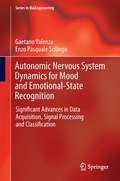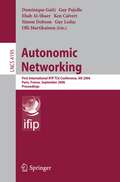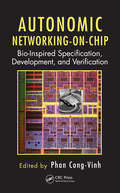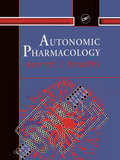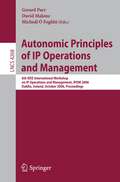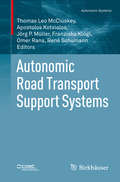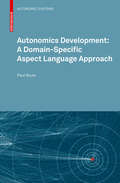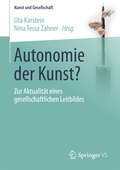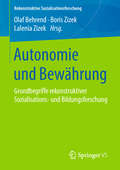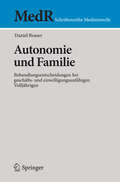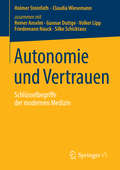- Table View
- List View
Autonomic Nervous System Dynamics for Mood and Emotional-State Recognition: Significant Advances in Data Acquisition, Signal Processing and Classification (Series in BioEngineering)
by Gaetano Valenza Enzo Pasquale ScilingoThis monograph reports on advances in the measurement and study of autonomic nervous system (ANS) dynamics as a source of reliable and effective markers for mood state recognition and assessment of emotional responses. Its primary impact will be in affective computing and the application of emotion-recognition systems. Applicative studies of biosignals such as: electrocardiograms; electrodermal responses; respiration activity; gaze points; and pupil-size variation are covered in detail, and experimental results explain how to characterize the elicited affective levels and mood states pragmatically and accurately using the information thus extracted from the ANS. Nonlinear signal processing techniques play a crucial role in understanding the ANS physiology underlying superficially noticeable changes and provide important quantifiers of cardiovascular control dynamics. These have prognostic value in both healthy subjects and patients with mood disorders. Moreover, Autonomic Nervous System Dynamics for Mood and Emotional-State Recognition proposes a novel probabilistic approach based on the point-process theory in order to model and characterize the instantaneous ANS nonlinear dynamics providing a foundation from which machine “understanding” of emotional response can be enhanced. Using mathematics and signal processing, this work also contributes to pragmatic issues such as emotional and mood-state modeling, elicitation, and non-invasive ANS monitoring. Throughout the text a critical review on the current state-of-the-art is reported, leading to the description of dedicated experimental protocols, novel and reliable mood models, and novel wearable systems able to perform ANS monitoring in a naturalistic environment. Biomedical engineers will find this book of interest, especially those concerned with nonlinear analysis, as will researchers and industrial technicians developing wearable systems and sensors for ANS monitoring.
Autonomic Networking: First International IFIP TC6 Conference, AN 2006, Paris, France, September 27-29, 2006, Proceedings (Lecture Notes in Computer Science #4195)
by Guy Pujolle Ehab Al-Shaer Ken Calvert Simon Dobson Guy Leduc Martikainen Dominique GaitiThis book constitutes the refereed proceedings of the First International IFIP TC6 Conference on Autonomic Networking, AN 2006. The 24 revised full papers presented were carefully reviewed and selected for inclusion in the book. The papers are organized in topical sections on autonomic networks, self-configuration, autonomic platform and services, autonomic management and discovery policy-based management, ad hoc, sensor and ambient autonomic networks, and autonomic control of mobile networks.
Autonomic Networking-on-Chip: Bio-Inspired Specification, Development, and Verification (Embedded Multi-Core Systems)
by Phan Cong-VinhDespite the growing mainstream importance and unique advantages of autonomic networking-on-chip (ANoC) technology, Autonomic Networking-On-Chip: Bio-Inspired Specification, Development, and Verification is among the first books to evaluate research results on formalizing this emerging NoC paradigm, which was inspired by the human nervous system. The FIRST Book to Assess Research Results, Opportunities, & Trends in "BioChipNets" The third book in the Embedded Multi-Core Systems series from CRC Press, this is an advanced technical guide and reference composed of contributions from prominent researchers in industry and academia around the world. A response to the critical need for a global information exchange and dialogue, it is written for engineers, scientists, practitioners, and other researchers who have a basic understanding of NoC and are now ready to learn how to specify, develop, and verify ANoC using rigorous approaches. Offers Expert Insights Into Technical Topics Including: Bio-inspired NoC How to map applications onto ANoC ANoC for FPGAs and structured ASICs Methods to apply formal methods in ANoC development Ways to formalize languages that enable ANoC Methods to validate and verify techniques for ANoC Use of "self-" processes in ANoC (self-organization, configuration, healing, optimization, protection, etc.) Use of calculi for reasoning about context awareness and programming models in ANoC With illustrative figures to simplify contents and enhance understanding, this resource contains original, peer-reviewed chapters reporting on new developments and opportunities, emerging trends, and open research problems of interest to both the autonomic computing and network-on-chip communities. Coverage includes state-of-the-art ANoC architectures, protocols, technologies, and applications. This volume thoroughly explores the theory behind ANoC to illustrate strategies that enable readers to use formal ANoC methods yet still make sound judgments and allow for reasonable justifications in practice.
Autonomic Networking-on-Chip: Bio-Inspired Specification, Development, and Verification (Embedded Multi-Core Systems)
by Phan Cong-VinhDespite the growing mainstream importance and unique advantages of autonomic networking-on-chip (ANoC) technology, Autonomic Networking-On-Chip: Bio-Inspired Specification, Development, and Verification is among the first books to evaluate research results on formalizing this emerging NoC paradigm, which was inspired by the human nervous system. The FIRST Book to Assess Research Results, Opportunities, & Trends in "BioChipNets" The third book in the Embedded Multi-Core Systems series from CRC Press, this is an advanced technical guide and reference composed of contributions from prominent researchers in industry and academia around the world. A response to the critical need for a global information exchange and dialogue, it is written for engineers, scientists, practitioners, and other researchers who have a basic understanding of NoC and are now ready to learn how to specify, develop, and verify ANoC using rigorous approaches. Offers Expert Insights Into Technical Topics Including: Bio-inspired NoC How to map applications onto ANoC ANoC for FPGAs and structured ASICs Methods to apply formal methods in ANoC development Ways to formalize languages that enable ANoC Methods to validate and verify techniques for ANoC Use of "self-" processes in ANoC (self-organization, configuration, healing, optimization, protection, etc.) Use of calculi for reasoning about context awareness and programming models in ANoC With illustrative figures to simplify contents and enhance understanding, this resource contains original, peer-reviewed chapters reporting on new developments and opportunities, emerging trends, and open research problems of interest to both the autonomic computing and network-on-chip communities. Coverage includes state-of-the-art ANoC architectures, protocols, technologies, and applications. This volume thoroughly explores the theory behind ANoC to illustrate strategies that enable readers to use formal ANoC methods yet still make sound judgments and allow for reasonable justifications in practice.
Autonomic Networks
by Dominique GaïtiAs the Internet becomes larger and larger, and consequently more difficult to control and to manage, telecommunication operators, manufacturers and companies require tools to perform management and control tasks. A large number of tools coming from different areas have been proposed, but these are not sufficient to handle an evolving and dynamic environment. This book presents and explains all the techniques which integrate a certain level of intelligence (through intelligent software agents for example) in order to represent knowledge, take appropriate decisions, communicate with other entities and achieve a self-managing network.
Autonomic Neurology (Contemporary Neurology Series #86)
by Eduardo E. BenarrochThe purpose of this book is to present a focused approach to the pathophysiology, diagnosis, and management of the most common autonomic disorders that may present to the clinical neurologist. Autonomic Neurology is divided into 3 sections. The first section includes 5 chapters reviewing the anatomical and biochemical mechanisms of central and peripheral nervous system control of autonomic function, principles of autonomic pharmacology, and a clinical and laboratory approach to the diagnosis of autonomic disorders. The second section focuses on the pathophysiology and management of orthostatic hypotension, postural tachycardia, baroreflex failure; syncope, disorders of sweating, neurogenic bladder and sexual dysfunction, gastrointestinal dysmotility, and autonomic hyperactivity. The final section is devoted to specific autonomic disorders, including central neurodegenerative disorders; common peripheral neuropathies with prominent autonomic failure; painful small fiber neuropathies; autoimmune autonomic ganglionopathies and neuropathies; focal brain disorders; focal spinal cord disorders; and chronic pain disorders with autonomic manifestations. This book is the product of the extensive experience of its contributors in the evaluation and management of the many patients with autonomic symptoms who are referred for neurologic consultation at Mayo Clinic in Rochester, Minnesota. Autonomic Neurology focuses on clinical scenarios and presentation of clinical cases and includes several figures showing the results of normal and abnormal autonomic testing in typical conditions. Its abundance of tables summarizing the differential diagnosis, testing, and management of autonomic disorders also help set this book apart from other books focused on the autonomic nervous system.
Autonomic Neurology (Contemporary Neurology Series #86)
by Eduardo E. BenarrochThe purpose of this book is to present a focused approach to the pathophysiology, diagnosis, and management of the most common autonomic disorders that may present to the clinical neurologist. Autonomic Neurology is divided into 3 sections. The first section includes 5 chapters reviewing the anatomical and biochemical mechanisms of central and peripheral nervous system control of autonomic function, principles of autonomic pharmacology, and a clinical and laboratory approach to the diagnosis of autonomic disorders. The second section focuses on the pathophysiology and management of orthostatic hypotension, postural tachycardia, baroreflex failure; syncope, disorders of sweating, neurogenic bladder and sexual dysfunction, gastrointestinal dysmotility, and autonomic hyperactivity. The final section is devoted to specific autonomic disorders, including central neurodegenerative disorders; common peripheral neuropathies with prominent autonomic failure; painful small fiber neuropathies; autoimmune autonomic ganglionopathies and neuropathies; focal brain disorders; focal spinal cord disorders; and chronic pain disorders with autonomic manifestations. This book is the product of the extensive experience of its contributors in the evaluation and management of the many patients with autonomic symptoms who are referred for neurologic consultation at Mayo Clinic in Rochester, Minnesota. Autonomic Neurology focuses on clinical scenarios and presentation of clinical cases and includes several figures showing the results of normal and abnormal autonomic testing in typical conditions. Its abundance of tables summarizing the differential diagnosis, testing, and management of autonomic disorders also help set this book apart from other books focused on the autonomic nervous system.
Autonomic Pharmacology
by Kenneth J BroadleyThis overview of autonomic pharmacology describes the anatomy, physiology and pharmacology of the autonomic involuntary nervous system. Covering the diverse group of drugs acting on the autonomous nervous system, their actions are reviewed together with their clinical uses, side effects, interactions and subcellular mechanisms of action. Information is organized in a logical flow, bringing together the latest advances in an integrated form on topics usually found only in a fragmented form.; This work is intended for all those researching in industry and academic institutions in pharmaceutical, pharmacological sciences, pharmacy, medical sciences, physiology, neurosciences, biochemistry and molecular biology.
Autonomic Pharmacology
by Kenneth J BroadleyThis overview of autonomic pharmacology describes the anatomy, physiology and pharmacology of the autonomic involuntary nervous system. Covering the diverse group of drugs acting on the autonomous nervous system, their actions are reviewed together with their clinical uses, side effects, interactions and subcellular mechanisms of action. Information is organized in a logical flow, bringing together the latest advances in an integrated form on topics usually found only in a fragmented form.; This work is intended for all those researching in industry and academic institutions in pharmaceutical, pharmacological sciences, pharmacy, medical sciences, physiology, neurosciences, biochemistry and molecular biology.
Autonomic Principles of IP Operations and Management: 6th IEEE International Workshop on IP Operations and Management, IPOM 2006, Dublin, Ireland, October 23-25, 2006, Proceedings (Lecture Notes in Computer Science #4268)
by Mícheál Ó Foghlú Gerard Parr David MaloneThis book constitutes the refereed proceedings of the 6th IEEE International Workshop on IP Operations and Management, IPOM 2006, held in Dublin, Ireland in October 2006 in the course of the 2nd International Week on Management of Networks and Services, Manweek 2006. The 18 revised full papers and four revised short papers presented were carefully reviewed and selected from 45 submissions.
Autonomic Road Transport Support Systems (Autonomic Systems #0)
by Thomas Leo McCluskey Apostolos Kotsialos Jörg P. Müller Franziska Klügl Omer Rana René SchumannThe work on Autonomic Road Transport Support (ARTS) presented here aims at meeting the challenge of engineering autonomic behavior in Intelligent Transportation Systems (ITS) by fusing research from the disciplines of traffic engineering and autonomic computing. Ideas and techniques from leading edge artificial intelligence research have been adapted for ITS over the last 30 years. Examples include adaptive control embedded in real time traffic control systems, heuristic algorithms (e.g. in SAT-NAV systems), image processing and computer vision (e.g. in automated surveillance interpretation). Autonomic computing which is inspired from the biological example of the body’s autonomic nervous system is a more recent development. It allows for a more efficient management of heterogeneous distributed computing systems. In the area of computing, autonomic systems are endowed with a number of properties that are generally referred to as self-X properties, including self-configuration, self-healing, self-optimization, self-protection and more generally self-management. Some isolated examples of autonomic properties such as self-adaptation have found their way into ITS technology and have already proved beneficial. This edited volume provides a comprehensive introduction to Autonomic Road Transport Support (ARTS) and describes the development of ARTS systems. It starts out with the visions, opportunities and challenges, then presents the foundations of ARTS and the platforms and methods used and it closes with experiences from real-world applications and prototypes of emerging applications. This makes it suitable for researchers and practitioners in the fields of autonomic computing, traffic and transport management and engineering, AI, and software engineering. Graduate students will benefit from state-of-the-art description, the study of novel methods and the case studies provided.
Autonomic Testing
by Peter NovakDDisorders associated with dysfunction of the autonomic nervous system are quite common yet frequently unrecognized. The quantitative autonomic testing presented here can be invaluable tool for evaluation of these disorders. This manual fills a gap in the literature and deals mainly with practical aspects of autonomic testing. In accord with the "good picture is worth a thousand words" mantra, signal drawings are heavy used throughout the text to facilitate the readers' knowledge. Autonomic Testing is the optimal guide for autonomic fellows, residents in neurology, general medicine and other specialties or for everybody that is interested in performing and interpreting autonomic tests. The unique aspect of this book is the use of the skin biopsies for assessment of small autonomic and sensory fibers as a routine part of autonomic testing. Another important feature of this book is the use of continuous cerebral blood flow velocity and end tidal CO2 monitoring in addition to standard heart rate and blood pressure recordings during the testing. Comprised of 100 unique case studies, each case solves a particular clinical question. The presented cases include neurally mediated syncope, psychogenic pseudosyncope, orthostatic intolerance syndromes, autonomic failure, variety of small fiber neuropathies (with and without autoimmunity), autonomic dysfunction in neurodegenerative and hypermobile disorders.
Autonomic Testing
by Peter NovakDDisorders associated with dysfunction of the autonomic nervous system are quite common yet frequently unrecognized. The quantitative autonomic testing presented here can be invaluable tool for evaluation of these disorders. This manual fills a gap in the literature and deals mainly with practical aspects of autonomic testing. In accord with the "good picture is worth a thousand words" mantra, signal drawings are heavy used throughout the text to facilitate the readers' knowledge. Autonomic Testing is the optimal guide for autonomic fellows, residents in neurology, general medicine and other specialties or for everybody that is interested in performing and interpreting autonomic tests. The unique aspect of this book is the use of the skin biopsies for assessment of small autonomic and sensory fibers as a routine part of autonomic testing. Another important feature of this book is the use of continuous cerebral blood flow velocity and end tidal CO2 monitoring in addition to standard heart rate and blood pressure recordings during the testing. Comprised of 100 unique case studies, each case solves a particular clinical question. The presented cases include neurally mediated syncope, psychogenic pseudosyncope, orthostatic intolerance syndromes, autonomic failure, variety of small fiber neuropathies (with and without autoimmunity), autonomic dysfunction in neurodegenerative and hypermobile disorders.
Autonomics Development: A Domain-Specific Aspect Language Approach (Autonomic Systems)
by Paul SouleDistributed applications are difficult to write as programmers need to adhere to specific distributed systems programming conventions and frameworks, which makes distributed systems development complex and error prone and ties the resultant application to the distributed system because the application's code is tangled with the crosscutting concern distribution. This book introduces the concept of a domain-specific aspect language called a Distribution Definition Language that generalises the distribution and distribution recovery concerns by describing the classes and methods of an existing application to be made remote, the distributed system to use to make them remote and the recovery mechanism to use in the event of an error. A software tool in the form of the RemoteJ compiler/generator that uses information contained in the Distribution Definition Language to generate the recovery and distributed system specific code and apply it to the application using bytecode manipulation and generation techniques is introduced. By allowing distribution and autonomic features, such as recovery, to be modularised and applied to existing applications this approach greatly simplifies distributed systems and autonomics development. This book is of particular interest to researchers and students of distributed systems, autonomics, domain-specific aspect languages and aspect-orientation.
Autonomie: Maßstab, Ideal oder Illusion? Vadian Lectures Band 9 (Sozialtheorie)
by Mathias Lindenau Marcel Meier KressigAutonomie und mit ihr die Selbstbestimmung gelten als hohes Gut. Demnach hat jeder Mensch das Recht, selbst darüber zu entscheiden, wie er leben möchte, und seine persönlichen Entscheide in der eigenen Lebensführung zu realisieren - und das ohne die Einmischung von anderen, auch staatlichen Stellen. Doch Selbstbestimmung ist nicht grenzenlos. Sie hat auch Rücksicht auf andere zu nehmen, deren Rechte zu achten und ist immer mit Verantwortung verbunden. Die Beiträger*innen des Bandes stellen sich diesem Spannungsfeld und fragen: Was heißt es unter diesen Vorzeichen, sich selbst zu bestimmen und ein gelungenes Leben zu führen? Und was bedeutet Autonomie für Entscheide am Lebensende und die personalisierte Medizin?
Autonomie der Kunst?: Zur Aktualität eines gesellschaftlichen Leitbildes (Kunst und Gesellschaft)
by Uta Karstein Nina Tessa ZahnerDie Autonomie der Kunst ist heute umstrittener denn je. Als Produkt bürgerlicher Emanzipationsbestrebungen erscheint sie mittlerweile vielen ideologieverdächtig. Aber auch die Verwendbarkeit des Begriffes der (Kunst-)Autonomie als einem analytischen Konzept wird immer wieder in Zweifel gezogen. Vor diesem Hintergrund unterzieht der vorliegende Band die verschiedenen soziologischen Autonomiekonzeptionen einer kritischen und empirisch gesättigten Überprüfung.
Autonomie und Abhängigkeit in der Altenpflege
by Helen SchneiderAusgehend von einem relationalen und dynamischen Autonomiebegriff fokussiert sich Helen Schneider auf die Frage, wie Pflegebedürftige in der stationären Altenpflege Abhängigkeit im Kontext von Autonomie und Identität erleben und verarbeiten. Anthropologische Perspektiven der Resilienz, Ich-Integrität, Generativität und Gerotranszendenz, aber auch Daseinsthemen und eine daseinsthematische Begleitung sind eminente Parameter in der Durchdringung dieser Fragestellung. Es zeigt sich, dass Abhängigkeiten in der stationären Altenpflege in Bezug zu früheren Erfahrungen gestellt und partiell mit diesen abgewogen werden. In diesem Kontext werden Copingstrategien angewendet, die entweder den Erhalt der Daseinsthemen und -techniken anstreben, ihren Verlust bewältigen oder deren Fokusverschiebung beeinflussen.
Autonomie und Bewährung: Grundbegriffe rekonstruktiver Sozialisations- und Bildungsforschung (Rekonstruktive Sozialisationsforschung)
by Olaf Behrend Boris Zizek Lalenia ZizekDer interdisziplinär angelegte Band bringt empirische, theoretische und methodologische Auseinandersetzungen mit den beiden Grundbegriffen zusammen. Exemplarisch wird gezeigt, welches Aufschlusspotential sich für eine rekonstruktive Sozial- und Erziehungswissenschaft ergibt. Mit den Begriffen ‚Autonomie‘ und ‚Bewährung‘ werden nicht reduzierbare Probleme und Leistungen des einzelnen Menschen und deren kulturelle Rahmenbedingungen wieder in den Fokus subjektorientierter Bildungsforschung gerückt.
Autonomie und Familie: Behandlungsentscheidungen bei geschäfts- und einwilligungsunfähigen Volljährigen (MedR Schriftenreihe Medizinrecht)
by Daniel BrauerBeiträge zur Patientenautonomie gibt es viele. Was bisher aber kaum Beachtung gefunden hat, ist das Verhältnis zwischen Patientenautonomie und der Familie als personellem Nahraum. Das vorliegende Buch schließt diese Lücke, indem es die Bedeutung von Familienangehörigen bei medizinischen Entscheidungssituationen geschäfts- und einwilligungsunfähiger Patienten untersucht. Der Autor bereitet die Thematik systematisch auf, indem er, ausgehend von einer Darstellung eines Autonomiekonzepts und den Grundlagen der medizinischen Behandlung, der Kernfrage nachgeht, wie die Familie in den Entscheidungsfindungsprozess einbezogen wird und warum. Aufbauend auf diesen Erkenntnissen untersucht der Autor, ob aus der Einbeziehung der Familie eine Gefährdung für die Autonomie des Einzelnen folgt. Abschließend wendet sich der Autor der Beteiligung von Familienmitgliedern in den Rechtsordnungen der USA und den sich aus einem Rechtsvergleich ergebenden Handlungsimpulsen für das deutsche Recht zu.
Autonomie und Gerechtigkeit: Das Beispiel der Familientherapie für eine therapeutische Ethik
by Stella Reiter-TheilAutonomie und Kalkulation: Zur Praxis gesellschaftlicher Ökonomisierung im Gesundheits- und Krankenhauswesen (Arbeit und Organisation #1)
by Kaspar MolzbergerDer Strukturwandel im Gesundheitswesen wird häufig als Effizienz- und Qualitätsgewinn zugleich gepriesen. Ein soziologischer Blick indes zeigt: was sich hinter der »Ökonomisierung« der Krankenversorgung verbirgt, ist ein höchst kontroverses Unterfangen. Kaspar Molzberger nimmt in Anlehnung an relationale Sozialtheorien eine Neubestimmung vor. Seine praxissoziologische Studie verdeutlicht, womit die nach professionellen Werten arbeitenden Berufsgruppen in Krankenhäusern zu kämpfen haben, wenn sie den neoliberalen Managementreformen zu entsprechen suchen. Es droht eine »Verkehrung des Gewöhnlichen«: Die Autonomie der Arzt- und Pflegeberufe wird nunmehr als kalkulative behandelt und es ist folglich das Krankenhaus, das mit immer mehr Kranken versorgt werden muss, um zu überleben.
Autonomie und Organisation: Die sozialwissenschaftliche Mystifikation der Verselbständigung von Organisationen (Beiträge zur sozialwissenschaftlichen Forschung #58)
by Friedrich SchönweissAutonomie und Steuerung verselbständigter Behörden: Eine empirische Analyse am Beispiel Deutschlands und Norwegens (Interdisziplinäre Organisations- und Verwaltungsforschung #19)
by Tobias BachEs gibt seit einigen Jahren eine internationale politik- und verwaltungswissenschaftliche Diskussion zu strukturell verselbständigten Behörden außerhalb der Ministerialverwaltung („Agencies“). Ausgangspunkt ist die Beobachtung, dass bei der Ausgestaltung der Steuerungsbeziehungen zwischen Ministerien und Behörden erhebliche Unterschiede festzustellen sind, die sowohl zwischen Behörden eines Landes als auch im internationalen Vergleich bestehen. Tobias Bach untersucht am Beispiel Deutschlands und Norwegens, wie sich nationale Reformverläufe einerseits und organisatorische Merkmale wie Struktur und Aufgabe andererseits auf Steuerungsbeziehungen auswirken. Die empirische Analyse stützt sich auf standardisierte Erhebungen, die im Rahmen des internationalen Forschungsnetzwerkes COBRA („Comparative Public Organization Data Base for Research and Analysis“) durchgeführt wurden.
Autonomie und Vertrauen: Schlüsselbegriffe der modernen Medizin
by Reiner Anselm Gunnar Duttge Volker Lipp Friedemann Nauck Silke SchicktanzDie Selbstbestimmung des Patienten wird in liberalen und individualisierten Gesellschaften zu Recht hochgehalten. Doch die Handlungsfreiheit des Einzelnen in einer hochkomplexen, von wissenschaftlich-technischen Rationalitäten durchstrukturierten Welt wächst nur in dem Maße, wie Personen- und Systemvertrauen ermöglicht wird. Denn mit den Handlungsmöglichkeiten der modernen Medizin wachsen auch Verletzlichkeit und Verunsicherung der Akteure. Die Beiträge dieses Bandes aus den Bereichen Philosophie, Medizinrecht, Theologie, Medizinethik und Medizin untersuchen, inwiefern interpersonelles Vertrauen bzw. Systemvertrauen und Selbstbestimmungspraktiken zusammenhängen. Ein besonderes Augenmerk gilt dabei Institutionen wie dem Krankenhaus sowie Kollektivakteuren wie Familien oder Patientengruppen.
